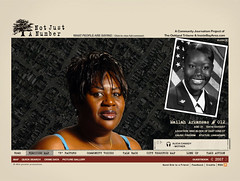I have only one prediction for 2008. I think we’re finally about to see the useful combination of the 4 W’s – Who, What, Where, and When.
Marc Davis has done some interesting research in this area at Yahoo!, and Bradley Horowitz articulated how he sees the future of this space unfolding in a BBC article in June ’07:
“We do a great job as a culture of “when”. Using GMT I can say this particular moment in time and we have a great consensus about what that means…We also do a very good job of “where” – with GPS we have latitude and longitude and can specify a precise location on the planet…The remaining two Ws – we are not doing a great job of.”
I’d argue that the social networks are now really honing in on “who”, and despite having few open standards for “what” data (other than UPC) there is no shortage of “what” data amongst all the “what” providers. Every product vendor has their own version of a product identifier or serial number (such as Amazon’s ASIN, for example).
We’ve seen a lot of online services solving problems in these areas either by isolating specific pieces of data or combining the data in specific ways. But nobody has yet integrated all 4 in a meaningful way.

Jeff Jarvis’ insightful post on social airlines starts to show how these concepts might form in all kinds of markets. When you’re traveling it makes a lot of sense to tap into “who” data to create compelling experiences that will benefit everyone:
“
- At the simplest level, we could connect while in the air to set up shared cab rides once we land, saving passengers a fortune.
- We can ask our fellow passengers who live in or frequently visit a destination for their recommendations for restaurants, things to do, ways to get around.
- We can play games.
- What if you chose to fly on one airline vs. another because you knew and liked the people better? What if the airline’s brand became its passengers?
- Imagine if on this onboard social network, you could find people you want to meet – people in the same business going to the same conference, people of similar interests, future husbands and wives – and you can rendezvous in the lounge.
- The airline can set up an auction marketplace for at least some of the seats: What’s it worth for you to fly to Berlin next Wednesday?
“
Carrying the theme to retail markets, you can imagine that you will walk into H&M and discover that one of your first-degree contacts recently bought the same shirt you were about to purchase. You buy a different one instead. Or people who usually buy the same hair conditioner as you at the Walgreen’s you’re in now are switching to a different hair conditioner this month. Though this wouldn’t help someone like me who has no hair to condition.
Similarly, you can imagine that marketing messages could actually become useful in addition to being relevant. If CostCo would tell me which of the products I often buy are on sale as I’m shopping, or which of the products I’m likely to need given what they know about how much I buy of what and when, then my loyalty there is going to shoot through the roof. They may even be able to identify that I’m likely buying milk elsewhere and give me a one-time coupon for CostCo milk.
Bradley sees it playing out on the phone, too:
“On my phone I see prices for a can of soup in my neighbourhood. It resolves not only that particular can of soup but knows who I am, where I am and where I live and helps me make an intelligent decision about whether or not it is a fair price.
It has to be transparent and it has to be easy because I am not going to invest a lot of effort or time to save 13 cents.”
It may be unrealistic to expect that this trend will explode in 2008, but I expect it to at least appear in a number of places and inspire future implementations as a result. What I’m sure we will see in 2008 is dramatic growth in the behind-the-scenes work that will make this happen, such as the development and customization of CRM-like systems.
Lots of companies have danced around these ideas for years, but I think the ideas and the technologies are finally ready to create something real, something very powerful.
Photo: SophieMuc
 After getting tired of watching the homicide count for 2006 climb higher and higher, they decided to humanize the issue and talk to the families of the victims directly. They wanted to expose the story beneath the number and give a platform upon which the community could make the issue real.
After getting tired of watching the homicide count for 2006 climb higher and higher, they decided to humanize the issue and talk to the families of the victims directly. They wanted to expose the story beneath the number and give a platform upon which the community could make the issue real. 